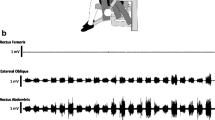Summary
A random sample of 778 subjects representing ages 25, 35, 45 and 55 years were studied for the amount of habitual physical activity, their anthropometric structure, vertical jumping height, trunk extension and flexion torques and dynamic endurance fitness of trunk extension and flexion. The proportion of subjects who were habitually physically active did not change systematically with age. The highest number of physically inactive subjects was found in men and women in the 35-year age group. The results in all the tests used to assess the strength characteristics were statistically significant when related to sex (P<0.001) and in all, except the relative maximal isometric torque of trunk extension, when related to age (P<0.001). Everyday physical activity was related to the variation in vertical jumping height (P<0.001), as well to the dynamic endurance fitness (P<0.001) of trunk extension and flexion. The decline in vertical jumping height and dynamic endurance fitness of trunk extension and flexion fitness was found to start at carlier ages than that of relative maximal isometric trunk extension and flexion torques. Dynamic endurance fitness of trunk flexion showed a more pronounced decline with age than trunk extension fitness.
Similar content being viewed by others
References
Aniansson A, Hedberg M, Henning G-B, Grimby G (1986) Muscle morphology, enzymatic activity and muscle strength in elderly men: a follow-up study. Muscle Nerve 9:585–591
Åstrand I (1960) Aerobic work capacity in men and women with special reference to age. Acta Physiol Scand 49, [Suppl 169]:1–92
Åstrand PO (1987) Exercise physiology and its role in disease prevention and in rehabilitation. Arch Phys Med Rehabil 68:305–309
Borges O (1989) Isometric and isokinetic knee extension and flexion torque in men and women aged 20–70. Scand J Rehabil Med 21:45–53
Bosco C (1980) Sei un grande athleta: Vediamo cosa dice l'Ergo-jump. Pallavolo 5:34–36
Bosco C, Komi PV (1979) Mechanical characteristics and fiber composition of human leg extension muscles. Eur J Appl Physiol 41:275–284
Bosco C, Komi PV (1980) Influence of aging on the mechanical behaviour of leg extensor muscles. Eur J Appl Physiol 45:209–219
Campbell MJ, McGomas AJ, Petito F (1973) Physiological changes in ageing muscles. J Neurol Neurosurg Psychiatry 36:174–182
Canada Fitness Survey (1983) Fitness and lifestyle in Canada. Government of Canada. Fitness and Amateur Sport. Canada Fitness Survey, Ottawa
Häkkinen K, Komi PV (1983) Electromyographic changes during strength training and detraining. Med Sei Sports Exerc 15:455–460
Hasue M, Fujiwara M, Kikuchi S (1980) A new method of quantitative measurement of abdominal and back muscle strength. Spine 5:143–148
Heikkinen E, Arajärvi R-L, Ara P, Jylhä M, Kinnunen V, Leskinen A-L, Leskinen E, Mässeli E, Pohjolainen P, Rahkila P, Suominen H, Turpeinen P, Väisänen M, Österback L (1984) Functional capacity of men born in 1906–1910, and 1946–1950. Scand J Soc Med [Suppl 33]:1–93
Johnson MA, Polgar J, Weightman D, Appleton D (1973) Data on the distribution of fibre types in thirty-six human muscles — an autopsy study. J Neurol Sci 18:111–129
Kuta I, Parizkova J, Dycka J (1970) Muscle strength and lean body mass in old men of different physical activity. J Appl Physiol 29:168–171
Larsson L (1982a) Aging in mammalian skeletal muscle. In: Mortimer JA, Pirozzolo FJ, Maletta CJ (eds) The aging motor system. Praeger, New York, pp 60–97
Larsson L (1982b) Physical training effects on muscle morphology in sedentary males at different ages. Med Sci Sports Exerc 14:203–206
Larsson L, Grimby G, Karlsson J (1979) Muscle strength and speed of movement in relation to age and muscle morphology. J Appl Physiol 46:451–456
Mälkiä E (1983) Muscular performance as a determinant of physical ability in Finnish adult population. Publications of the Social Insurance Institution AL:23, Turku, Finland
Moritani T, de Vries H (1979) Neural factors versus hypertrophy in the time course of muscle strength gain. Am J Phys Med 58:115–130
Saltin B (1982) Physical fitness of elderly people. In: Magnussen G, Pallesen AE, Viidik A (eds) Den normale aldring, vol II, Copenhagen, pp 201–215
Simoneau JA, Cortie G, Boulay MR, Marcotte M, Thibault MC, Bouchard C (1985) Human skeletal muscle fiber type alteration with high-intensity intermittent training. Eur J Appl Physiol 54:250–253
Viitasalo JT, Komi PV (1981) Interrelationships between electromyographic, mechanical, muscle structure and reflex time measurements in man. Acta Physiol Scand 111:97–103
Viitasalo JT, Komi PV, Karvonen MJ (1977) Physical health and performance capacity and physical activity habits in conscripts in the beginning of service at Air Force Communications School. Research Reports from the Department of Biology of Physical Activity, no. 19, University of Jyväskylä, Jyväskylä, Finland
Viitasalo JT, Era P, Leskinen A-L, Heikkinen E (1985) Muscular strength profiles and anthropometry in random samples of men aged 31–35, 51–55 and 71–75 years. Ergonomies 28:1563–1574
Viitasalo JT, Viljanen T, Kujala U (1989) Evaluation of vertical jumping tests. The XII International Congress of Biomechanics. 26–30 June, Los Angeles, USA. Available from the Department of Kinesiology, UCLA, California, USA
Viljanen T (1989) Physical activity counselling - the way to motivate healthy adults to exercise. In: Kvist M (ed) Paavo Nurmi Congress Book. Grafia, Turku, Finland, pp 169–174
Viljanen T, Viitasalo JT, Kujala U (1989) Isometric trunk extension and flexion strength of Finnish urban women and men aged 2555 years. In: Telama R, Laakso L, Pieron M, Ruoppila I, Vihko V (eds) Physical education and life-long physical activity. Gummeruksen Kirjapaino, Jyväskylä, Finland, pp 550–559
Author information
Authors and Affiliations
Rights and permissions
About this article
Cite this article
Viljanen, T., Viitasalo, J.T. & Kujala, U.M. Strength characteristics of a healthy urban adult population. Europ. J. Appl. Physiol. 63, 43–47 (1991). https://doi.org/10.1007/BF00760799
Accepted:
Issue Date:
DOI: https://doi.org/10.1007/BF00760799




